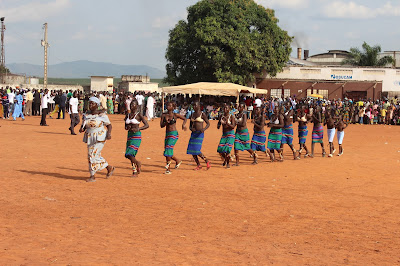 |
| Miss Monde 2016 et ses dauphines |
La plus belle femme au monde s’appelle Stéphanie Del Valle. La jeune Portoricaine élue Miss Monde 2016, a reçu sa couronne des mains de l’Espagnole Mireira Lalaguna qui avait remporté ce titre en 2015.
La cérémonie a eu lieu dimanche 18 décembre à Oxon Hill, près de Washington.
Yaritza Miguelina Reyes Ramirez de nationalité dominicaine est la première dauphine. Elle est suivie de Natasha Mannuella, Miss Indonésie 2016.
Evelyn Niambi Thungu, Miss Kenya, arrive en 4ème position. La Philippine Catriona Gray complète le Top 5 de cette 66ème édition qui mettait en lice 117 candidates.
Miss Monde 2016 a 19 ans. Elle est étudiante en communication à la
Pace University, située à New York. Avant son couronnement dimanche dernier, elle faisait du mannequinat. Elle est notamment la muse du designer porto-ricain Carlos Alberto.
L’Afrique était
représentée à ce concours de beauté par 16 pays : L’Afrique du Sud, la
Côte d’Ivoire, l’Egypte, le Ghana, la Guinée, la Guinée équatoriale, la Guinée
Bissau, le Kenya, le Lesotho, l’Ile Maurice, l’Ouganda, la République
démocratique du Congo, les Seychelles, la Sierra Leone, le Soudan du Sud, la
Tanzanie et la Tunisie.
Stéphanie Del Valle parle trois langues : espagnol, anglais et français. Elle souhaite désormais travailler dans l’industrie du divertissement.
 |
| Passation de couronne |
Bon à savoir:
Miss Monde 2016: Stéphanie del Valle, Porto Rico
1ère dauphine: Yaritza Miguelina Reyes Ramírez République Dominicaine
2ème dauphine: Natasha Mannuela, Indonésie
Top 5
•
Kenya : Evelyn Njambi Thungu
•
Porto Rico : Stephanie del Valle
•
Indonésie : Natasha Mannuela
•
République Dominicaine : Yaritza Miguelina Reyes Ramírez
•
Philippines : Catriona Gray
Top 10
• Philippines : Catriona Gray
• Indonésie : Natasha Mannuela
• Belgique : Lenty Frans
• Brésil : Beatrice Bessera de Fontoura
• Kenya : Evelyn Njambi Thungu
• République Populaire de Chine : Jing Kong
• République Dominicaine : Yaritza Miguelina Reyes Ramírez
• Porto Rico : Stephanie del Valle
• Etats-Unis : Audra Mari
• Corée : Hyun Wang
• Mongolie : Bayartsetseg Altangerel (Choix du peuple)
Top 20
• République Populaire de Chine: Jing Kong
• Philippines : Catriona Gray
• Les îles Cook : Natalia Short
• Mongolie : Bayartsetseg Altangerel
• Indonésie : Natasha Mannuela
• France : Morgane Edvige
• Kenya : Evelyn Njambi Thungu
• Etats-Unis : Audra Mari
• Inde : Priyadarshini Chatterjee
• Slovaquie : Kristina Cincurova
• Belgique : Lenty Frans
• Porto Rico : Stephanie del Valle
• Australie : Madeline Cowe
• Thaïlande : Jinnita Buddee
• Brésil : Beatrice Bessera de Fontoura
•
Ghana : Anthoinette Delali Kemavor
• Japon : Priyanka Yoshikawa
• République Dominicaine : Yaritza Miguelina Reyes Ramírez
• Hongrie : Timea Gelencser
• Corée : Hyun Wang
 |
| Euphorie |
 |
| Émotions |
 |
| Miss Kenya Evelyn Njambi Thungu, à droite (Photo) |
 |
| Majestueuse ! |
 |
| Stéphanie Del Valle |
 |
| En toute simplicité avec la légende Nadal |

















































